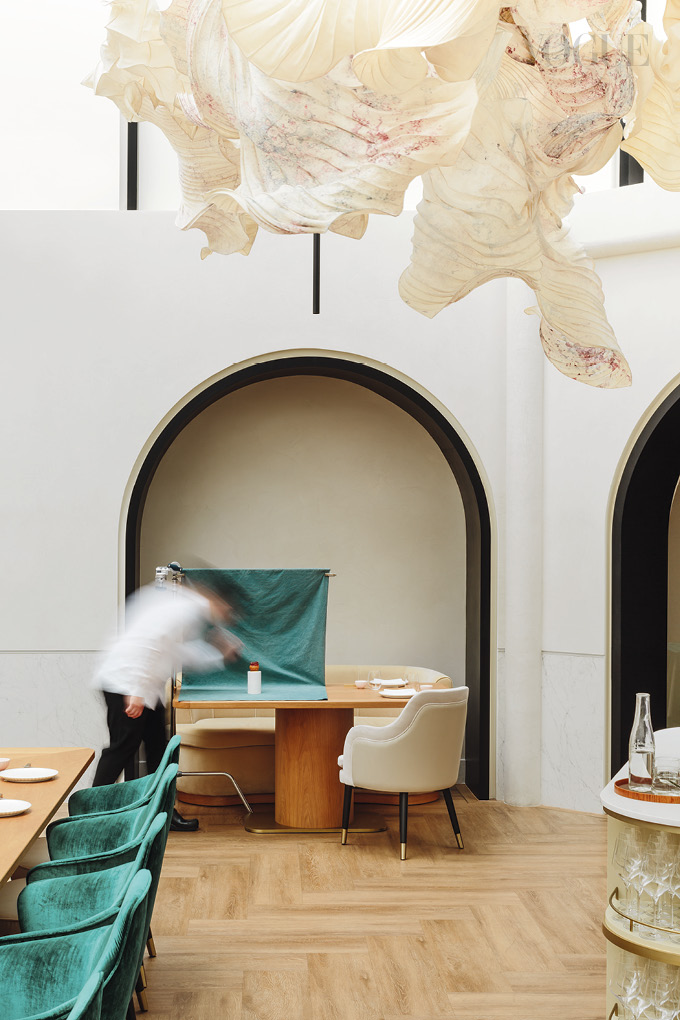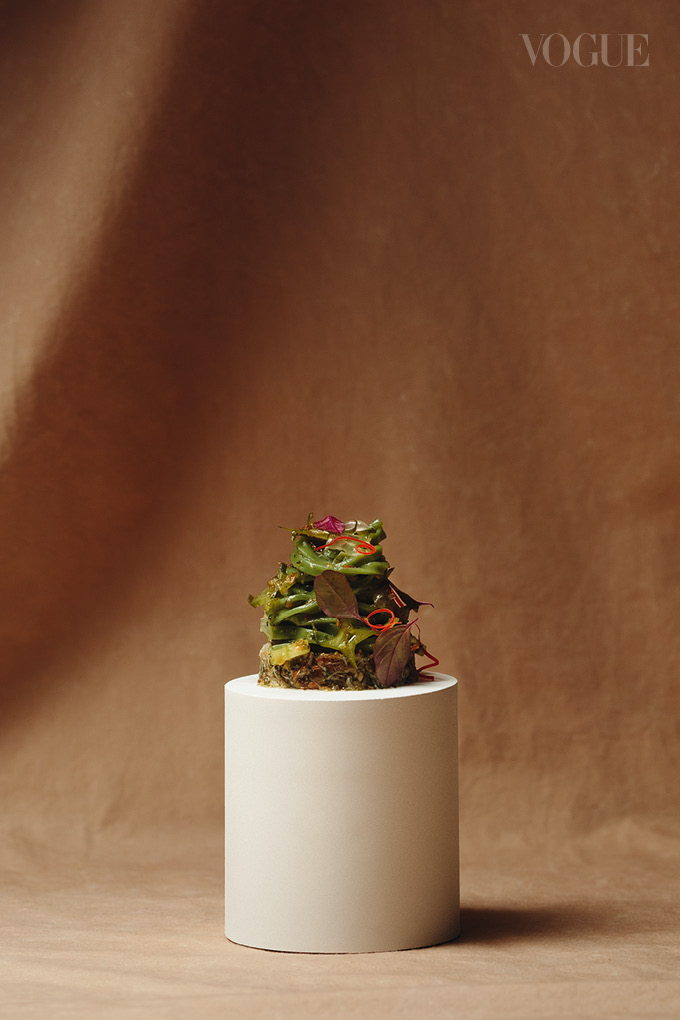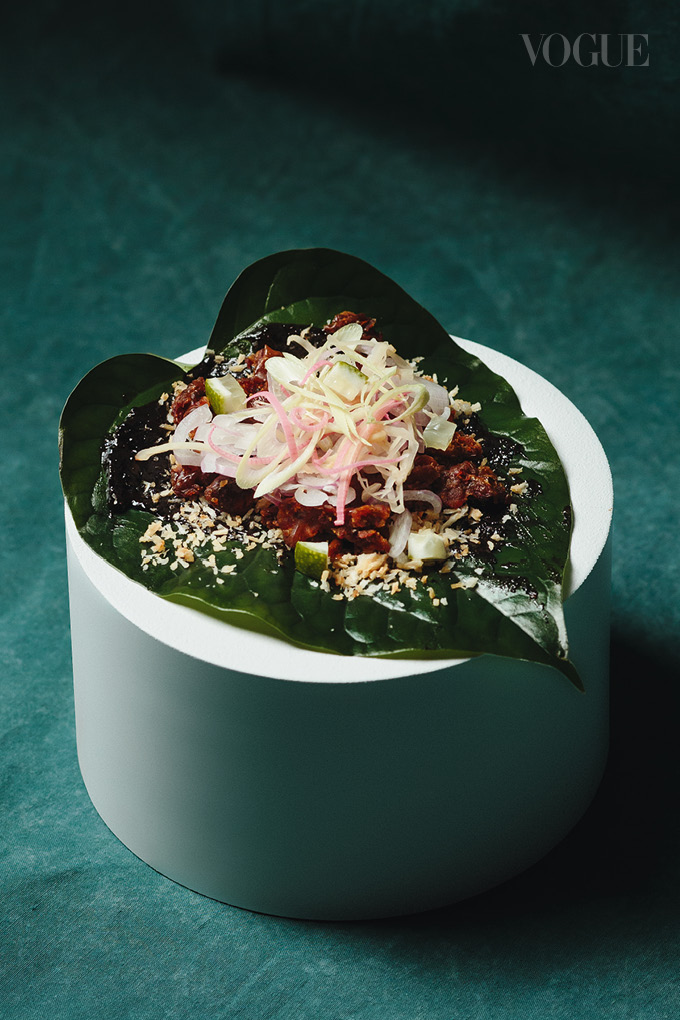Zor Tan, Born
Zor Tan would like to get the message out that Born is not a Chinese restaurant. “I wouldn’t want anyone to be disappointed, especially if they make a reservation not knowing what we actually do,” he laughs.
What Tan means, of course, is that the restaurant doesn’t serve traditional Chinese cuisine. With dishes like fish maw wrapped in cabbage and a bao seasoned with Szechuan peppercorn on his menu, it would be hard to argue that the gorgeous restaurant has no association with Chinese cuisine at all.

What Born does is build a rich culinary tapestry of Tan’s most pivotal memories—many of which are tied to his childhood and heritage. Growing up, Tan’s parents were hawkers. They ran an ‘economy rice’ (cai fan) stall in Johor Bahru and would prepare a wide range of dishes to put up in their stall window each day.
“My parents used food as a vehicle to show their love for me. I’d come home from school and have all these choices waiting—they would make sure to keep a chicken drumstick for me as they knew I loved it. I’ve always known food to be contentment.”
Tan pays tribute to his parents through Born, which is easily one of the most outstanding fine-dining experiences that have opened in Singapore in the last few years, demonstrating a level of finesse that proves Tan is a force to watch in our culinary scene. Often a fan favourite at cai fan stalls, the ubiquitous sesame sauce-drenched stir-fried eggplant is creatively interpreted in one of the eight snacks that comprise the first course. Tan cuts crispy baked chicken skin into thin wafers that sandwich roast eggplant, resulting in a savoury mille feuille that playfully conjures the humble dish it has evolved from.

Another key figure at Born is Tan’s wife, with whom he shares two children. One of his best dishes—fresh barramundi fish maw wrapped with Chinese cabbage and caul fat, an Asian spin on the classic French chou farci—is dedicated to her, inspired by something he tried to prepare during her confinement period after their first child was born.
“Honestly, when I first made fish maw for my wife, she didn’t really enjoy it. She found it too fishy. But I’m convinced she was still extra sensitive to food post-pregnancy,” Tan laughs. “I tried several different versions before I landed on one that she liked and found interesting. I am who I am today because of her.”
Tan’s degustation menu takes the diner on a journey through the flavours that best represent his life. One delicious plate transports you to Spain—inspired by Tan’s time in Restaurant Diverxo, where a Spanish chef he worked with made a stuffed bread that reminded him instantly of the baos he ate back home. At Born, Tan reinvents the memory through a deep-fried golden-brown bao, filled with beef tartare marinated in Szechuan peppercorn and chilli oil. In other words, a finely orchestrated collision of worlds.
Kevin Wong, Seroja
At 30, Kevin Wong has lived several lifetimes. Wong became the head chef of the one-Michelin-starred Meta six years ago, instantly distinguishing himself as one of the brightest young chefs in Asia. Now, he is exploring the rich diversity of the Malay Archipelago with his new restaurant, Seroja.
Wong was born in Klang, a historic town in the state of Selangor, Malaysia. As a fisherman’s son, he went out looking for part-time work as a 14-year-old student and stumbled upon his first fateful brush with the culinary world as a waiter at Lafite, a French fine-dining restaurant in Shangri-La Kuala Lumpur.

“It was hard work—I would go to the restaurant after school and then pull a double shift. When I first started, I didn’t even know how to hold a knife,” Wong shares. Two years later, he was scouted by the chefs he worked with and invited to move to France. He spent his late teenage years travelling from Europe to the US, working his way through every imaginable position that exists in a fine-dining kitchen.
“We were living in dormitories and sleeping in bunk beds with eight people to a room. Rent was so expensive that I’d sleep in the streets some nights. But it was the experience of a lifetime—working with the best chefs in the world in three-Michelin-starred restaurants and honing our craft.”
Now at the helm of his own restaurant and armed with a desire to decolonise fine-dining, Wong is carefully handpicking and exalting the wealth of ingredients, dishes and culinary practises found throughout Malaysia. “Our food is valuable. It is unique, it is delicious, and it is worth sharing with the world as loudly and proudly as we can.”
With the help of his kitchen team, Wong puts out an array of exquisite Malaysian-inspired dishes that look as good as they taste. His flavours are bold but carefully balanced—like a Hokkaido scallop slow-cooked in garlic oil and served alongside a trio of sauces informed by Wong’s personal history. He uses lily bulbs and tamarind in the dish to give it its distinctive depth, commemorating his grandmother who used to combine lily bulbs with tamarind and fish sauce in her own kitchen.
“Malaysian food is valuable. Our dishes are unique, delicious and diverse—and worth sharing with the world”
A noodle dish named Mee Ulam comes out bright green. The springy, glistening noodles are made by combining betel leaf juice and unrefined wheat flour, an old method originating in the peninsula that was once lost, but is now being revived under Wong’s watchful eye.
Wong makes special efforts to source items from the Malaysian Archipelago. He does this not in an attempt to create an arbitrary sense of authenticity, but to spotlight ingredients and recipes that are uniquely Malaysian and worth celebrating with a wider audience. The noodles in Mee Ulam are complemented by mud crab from the mangroves of Selangor (as opposed to the cheaper but more widely used Sri Lankan variety) because the former lends the dish a special, unmistakable flavour.
Every diner is welcomed with a glass of Toddy, a beverage made from fermented coconut water that was popularised in the colonial period by Indian rubber plantation workers in Malaysia, since coconut trees proliferated in the areas where the community lived and worked.
Toddy is yet another example of a lost recipe Wong has brought back to life through Seroja. He shares: “I once had a 70-year-old guest approach me nearly in tears after taking a sip of the drink. He said to me, ‘Kevin, my father would buy this for me back home. I haven’t had it since I was a child’.”
MJ Teoh, Native
Min Jun Teoh’s mother has never had a meal in her restaurant. Teoh—better known to most as MJ—has been a head chef for nearly two years now, but her mother (whose maiden name is Ah Moy, but this will only be important later) steadfastly refuses to visit.
“She’d be embarrassed to know that I’m telling you this,” Teoh laughs. “If I asked her why she doesn’t want to come, she’ll claim it’s because they [Teoh’s parents] don’t eat out much. They are very health conscious and they prefer the comfort of eating in their home.”

Teoh leads the kitchen team at Native. Anyone familiar with nightlife in Singapore will recognise Native as one of the city’s original craft cocktail bars—a veritable institution in its own right. The bar pioneered the use of unique ingredients like Ceylon Arrack (a traditional Sri Lankan spirit made from coconut flower sap), buah keluak and ants—yes, the insect. Native’s newly launched restaurant arm has corresponding fortes in regional and local flavours, sustainable practises and unrestricted creativity.
It might be an impossible task to find a better chef to head Native’s culinary thrust than Teoh, who is so unmistakably a Singapore heartlander that learning of the time she spent in New York—working at the now-shuttered DBGB NYC, a laid-back spin on the legendary DB Bistro—almost comes as a surprise.
“Our Miang Kham isn’t perfectly authentic because we source ingredients locally and make a special sauce. But it honours the flavours of the original dish in the best way we know how”
One of the best dishes on Native’s menu is Nose to Tail Chicken Pao Fan, an elevated take on the local classic. The broth is made by leaving roasted chicken wings and feet on a slow simmer, brewing and thickening into a warm, comforting potion belying great depth of flavour. Organic chicken thigh and gizzards are served on the side, along with a dish of puffed rice to soak up every droplet of liquid gold. Pairing this with one of Native’s ice-cold, spirit-forward cocktails creates a wisp of magic that would be difficult to replicate in any other restaurant in Singapore.
Teoh’s cuisine pays tribute to Singaporean food as much as it does all the regional dishes that have played a formative role in her life. Her Miang Kham—which sparks a fond memory of her Thai teacher at culinary school—arrives at the table separated into components in a grid-shaped tray. When put together, the dish forms an individualised parcel, enclosing a melange of bright flavours that coalesce into one perfect bite. “The Miang Kham isn’t perfectly authentic because we source ingredients locally and make the special sauce ourselves. But it honours the flavours of the original dish in the best way we know how.”
The real powerhouse behind Native’s food lies in a simple condiment. Bright, fiery and infused with a hint of tang, the house-made chilli sauce accompanies several dishes at the restaurant. It pays homage to the Singaporean obsession with chilli—and is named after the talented lady who created the recipe and served as Teoh’s earliest culinary inspiration. When you visit Native, don’t forget to ask for a serving of Ah Moy’s Chilli.
Photography and creative direction Sayher Heffernan
Production assistants Chandreyee Ray and Jesslyn Lye





